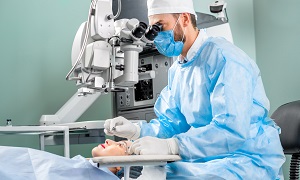Best Doctors in India for Keratoplasty
- Opthalmologist, Chennai, India
- Over 26 years’ experience
Profile Highlights:
- Dr. Pratik Ranjan Sen is a specialist in Ophthalmology and serves as an Ophthalmologist – Consultant at Apollo Hospitals, Chennai.
- He has performed over 8000 Retinal detachment and other Vitreo retinal disorder surgeries.
- Dr. Pratik Ranjan Sen considers his profession a mission and is dedicated to his work. Due to this, he has gained enough trust and recommendations from his patients.
- Ophthalmologist, Chennai, India
- Over 21 years’ experience
Profile Highlights:
- Dr. Viswanathan P is one of the best eye surgeons in India having an overall experience of 21 years.
- He is a qualified doctor from the Tamil Nadu University of India and possesses a degree in MBBS and MS.
- One can visit him for routine eye check-ups or retina examinations and services like eye surgery, retina surgery, cataract surgery, etc.
- Ophthalmologist, Gurugram, India
- Over 13 years’ experience
Profile Highlights:
- Dr. Svati Bansal is an esteemed consultant and practitioner of ophthalmology in Gurugram.
- Her specialty lies in orbit and oculoplasty, ocular oncology, ocular trauma, and neuro-ophthalmology.
- She has fellowships in neuro-ophthalmology and ocular motility, oculoplasty, and facial aesthetics, and ocular oculoplastic and ocular oncology.
Best Hospitals in India for Keratoplasty
Pushpawati Singhania Hospital & Research Institute, New Delhi
- City: New Delhi, India
Hospital Highlights:
- Established in 1996, Pushpawati Singhania Research Institute is one of the top hospitals in the NCR region, as well as one of the top facilities in India for gastroenterology. The hospital is one of South Asia’s first institutes in medical and surgical treatment for diseases related to digestion.
- The hospital is equipped with state-of-the art facilities coupled with the latest equipment as well as renowned consultants from various parts of India as well as other parts of the world.
W Pratiksha Hospital, Gurgaon
- City: Gurugram, India
Hospital Highlights:
- W Pratiksha Hospital, Gurugram, is one of the best hospitals in the NCR region. It is also a top hospital in India for IVF. Since its inception, the hospital has performed over 5500 successful IVFs. The hospital also specializes in gynecology.
- With over 20 years of experience in providing quality healthcare, the hospital is known as one of the most trusted and valued health providers in India.
- Equipped with world-class medical facilities and advanced technology, the hospital’s doctors and clinicians also have a track record of delivering excellent results. The hospital is also known for focusing on preventive well-being as much as on curative treatment.
- The hospital has earned the trust of its patients, by providing the best available treatments at affordable costs.
Narayana Superspeciality Hospital, Gurugram
- City: Gurugram, India
Hospital Highlights:
- Situated near DLF Cyber City, Gurugram, Narayana Superspecialty Hospital is one of the top medical facilities in the Delhi NCR region, catering to the needs of the people. Known for its commitment to quality medical care and patient service, the hospital is a state-of-the-art facility with planned and well-equipped sections, which includes a spacious OPD area as well as comfortable patient rooms.
- It is the closest super-specialty hospital from Indira Gandhi International Airport towards Gurugram, and also the nearest super specialty hospital from DLF Cyber City. It is also close to major residential areas in Gurugram.
- It is part of the renowned Narayana Health Group. Established in 2000, by Dr. Devi Shetty, a renowned cardiac surgeon, it has grown to be one fo India’s leading healthcare groups.
Sir Ganga Ram Hospital, New Delhi
- City: New Delhi, India
Hospital Highlights:
- Sir Ganga Ram Hospital, New Delhi is known to provide the latest medical procedures with the latest technology in all of its units.
- The hospital has a team of reputed doctors, nurses, and healthcare professionals that ensure that patients receive quality care at affordable costs.
- Staffed with a team of highly qualified doctors, dedicated nurses, and paramedical and non-medical staff, the hospital aims to lead in healthcare delivery, medical education, training, and research.
- As per the vision of the founder, the hospital also provides free treatment to the economically weaker sections of society.
- Sir Ganga Ram Hospital also provides training to young doctors under the Diplomate in National Board(DNB) program. The DNB program at the hospital was started in 1984 and it is known for currently running the maximum number of DNB specialties in the country. It also has the distinction of having the first bone bank in India.
KIMS Hospital, Hyderabad
- City: Hyderabad, India
Hospital Highlights:
- KIMS Hospital (a brand name of Krishna Institute of Medical Sciences) is one of the largest and best multi-speciality hospitals in Hyderabad. The hospital provides various treatments to an enormous number of patients.
- The hospital has a capacity of more than 3000 beds. KIMS Hospitals offers different healthcare services in more than 25 specialities and super specialities.
- The hospital is equipped with modern medical equipment and technology. It has robotic equipment to provide minimal invasive techniques for patients.
- The hospital is aimed at providing world-class healthcare facilities and services at an affordable cost for patients.
- The various specialities and departments of the hospital include neurosciences, gastroenterology & hepatology, robotic science, reproductive sciences, dental science, oncological sciences, organ transplantation, heart and lung transplantation and mother and child care.
Fortis Hospital, Shalimar Bagh
- City: New Delhi, India
Hospital Highlights:
- Fortis Hospital in Shalimar Bagh is a multi-super specialty hospital that strives to provide world-class patient care by leaving no stone unturned.
- Fortis, Shalimar Bagh, with 262 beds and a 7.34-acre footprint, provides the best level of medical care through its team of doctors, nurses, technicians, and management professionals.
Reliance Hospital, Mumbai
- City: Mumbai, India
Hospital Highlights:
- Reliance Hospital is one of the best super-specialty care hospitals in Navi Mumbai.
- The main purpose of this hospital is to become a trustworthy place for the best health and hope for society. The hospital is well connected to the suburbs of Mumbai and Navi Mumbai.
- The hospital has various specialty departments, viz., Accident & Emergency, Anesthesiology, Dental Services, Dermatology, Diabetology, Dietetics Nutrition, Endocrinology, ENT, Gastroenterology, General Surgery, Gynaecology And Obstetrics, Hepato Pancreato Biliary Surgery, Infectious Disease, Internal Medicine, Interventional Radiology, Laboratory Medicine, Minimal Access Laparoscopic Surgery, Nephrology, Neurosciences, Opthalmology, Orthopaedics, Paediatrics, Pain Management Palliative Care, Physical Medicine Rehabilitation, Plastic And Reconstructive Surgery, Psychiatry, Pulmonary Medicine, Radiology, Rheumatology, Transplant, Urology Andrology, Vascular Surgery
Lilavati Hospital & Research Centre, Mumbai
- City: Mumbai, India
Hospital Highlights:
- Lilavati Hospital & Research Centre is India’s premier multi-speciality tertiary care hospital and has been recognised as a global medical excellence centre.
- Lilavati Hospital & Research Centre has built an unrivalled level of trust with its patients over the years, thanks to a solid foundation that comprises cutting-edge facilities, the best medical competence, research, education, and charity endeavours.
- The hospital is quite proud of the fact that it now serves patients from all kinds of backgrounds, not just from the United States but from all around the world.
- The hospital has a total of 323 beds, one of the largest Intensive Care Units (ICUs), 12 Operation Theatres with modern amenities, over 300 consultants, and almost 1,800 personnel.
Venkateshwar Hospital, Dwarka, New Delhi
- City: New Delhi, India
Hospital Highlights:
- State-of-the-art technology and devoted healthcare professionals have been brought together under one roof at Venkateshwar Hospital to provide genuine medical care. The hospital’s professionals work together as a team to deliver the best possible treatment to their patients, using the most sophisticated equipment and information technology.
- Venkateshwar Hospital’s mission is to attain global excellence in healthcare by employing evidence-based, ethical clinical practices and cutting-edge technology by a team of highly skilled experts.
Keratoplasty
Cornea transplant also termed as keratoplasty, is a surgical procedure for replacing a part of your cornea with corneal tissue from a donor. This procedure is meant to restore vision, reduce your pain as well as improve the appearance of your cornea if it has been diseased or damaged.
The majority of cornea transplants are generally successful. But every cornea transplant carries with it a small risk of complications, such as rejection of the donor cornea.
The cornea is a very important organ, as it helps protects your eyes from germs, dust as well as other foreign particles. The cornea also permits light to enter your eyes.
Purpose
The purpose of keratoplasty or corneal transplant is to restore vision to people who suffer from a damaged cornea. The transplant may relieve pain or other signs and symptoms which are associated with diseases of the cornea.
This procedure can be considered for several reasons:
- A cornea that bulges outward
- Fuchs’ dystrophy
- Thinning of the cornea
- Clouding of the cornea
- Swelling of the cornea
- Cornea scarring, which can be caused by infection or injury
- Complications caused by previous eye surgery
- Corneal ulcers, including those that are caused by infection
Preparation
Before you undergo the procedure, you will need to go through the following:
A thorough eye exam
A review of medications and supplements that you take
Measurements of your eye
Treatment for other eye problems
Sometimes, unrelated eye problems, such as infection or inflammation, might lessen your chances of having a successful transplant. Therefore, in such cases, your eye doctor can work to treat those problems before your surgery.
Your health providers will let you know what you should expect during the procedure and will also discuss all risks and complications.
Corneas used in keratoplasty generally come from deceased donors. However, unlike people who need livers or kidneys, people needing a cornea transplant doesn’t usually need to wait very long. This is because many people request specifically that their corneas should be available for donation after they die unless they have had certain conditions.
If a donor has had several serious conditions such as certain central nervous system conditions, then his/her cornea may not be used. If the donor died from an unknown cause, in such a case, his/her cornea might not be used as well.
Procedure
On the day of your procedure, first, you will receive a sedative. It will help you to relax. You will also receive a local anesthetic to numb your eye and though you will not be asleep during the surgery, you will not feel any pain.
Penetrating keratoplasty is generally the most common type of cornea transplant. In this method, your surgeon will cut through the entire thickness of the abnormal or diseased cornea for removing a small button-sized disk of corneal tissue. He/she might use a small instrument to make this precise circular cut.
The donor cornea is then fit and placed in the opening. Your surgeon will then use an ultra-fine thread which will remain in place till your eye is completely healed.
This procedure generally takes one to two hours. You will spend an additional one or two hours in the recovery room.
After the procedure
Once the surgery is complete, you might receive several medications. This can include eye drops and sometimes oral medications which can help you control infection, swelling and pain.
You will receive an eye patch as well, as it can help protect your eye during the healing process after the surgery. Take all necessary precautions to protect your eye from any injury. Some extra precautions might be required for the rest of your life.
Return to your doctor for frequent follow-up exams, so that your doctor can look and examine if there have been any complications.
People who undergo this procedure can generally have their vision at least restored partially. What you expect after this procedure, generally depends on your surgery and your health.
Your risk of complications and cornea rejection can continue for years after the transplant. This is why you should consider seeing your doctor at least once every year.
It is also noteworthy that your vision will likely be worse than before your surgery, as your eye adjusts to the new cornea. Please note that for your vision to improve, it may take several months.
Risks
Generally, cornea transplant is quite safe, though it carries a small risk of a few complications, which include:
- Eye infection
- Increased risk of clouding of the eye’s lens, also termed as cataract
- Pressure increase within the eyeball, also known as glaucoma
- Problems with the stitches used to secure the donor cornea
- Swelling of the cornea
- Rejection of the donor cornea
Sometimes, your body’s immune system can attack the donor cornea mistakenly, which is known as rejection. This can require medical treatment or in some cases, another cornea transplant.
Signs of symptoms of rejection include:
- Redness
- Sensitivity to light
- Loss of vision
- Pain
Rejection generally occurs in around 10 percent of all cornea transplants.

















